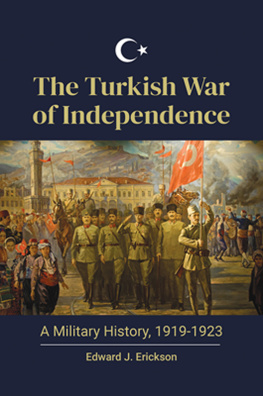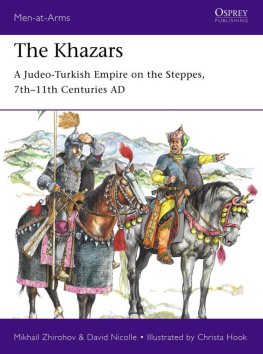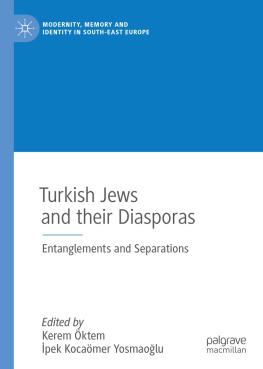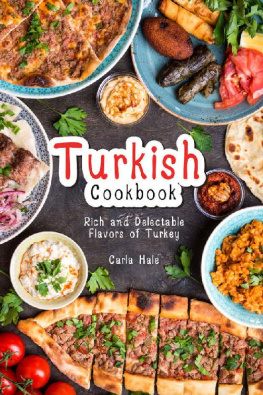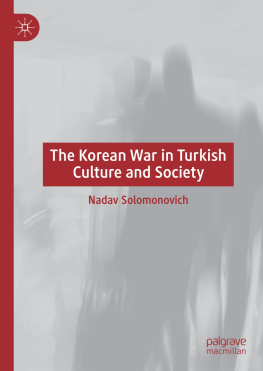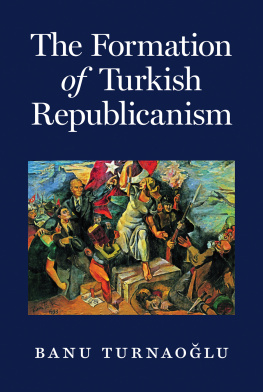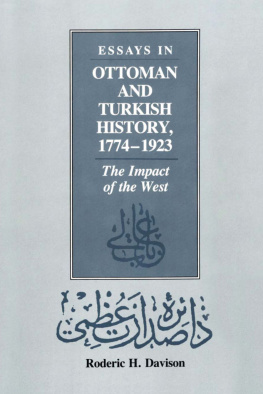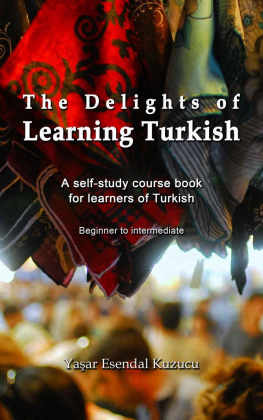The Turkish War of
Independence
The Turkish War of
Independence
A Military History, 19191923
Edward J. Erickson

Copyright 2021 by Edward J. Erickson
All rights reserved. No part of this publication may be reproduced, stored in a retrieval system, or transmitted, in any form or by any means, electronic, mechanical, photocopying, recording, or otherwise, except for the inclusion of brief quotations in a review, without prior permission in writing from the publisher.
Library of Congress Cataloging-in-Publication Data
Names: Erickson, Edward J., 1950-author.
Title: The Turkish War of Independence : a military history, 19191923 / Edward J. Erickson.
Description: Santa Barbara, California : Praeger, an imprint of ABC-CLIO, LLC, [2021] | Includes bibliographical references and index.
Identifiers: LCCN 2021008010 (print) | LCCN 2021008011 (ebook) | ISBN 9781440878411 (hardcover) | ISBN 9781440878428 (ebook)
Subjects: LCSH: TurkeyHistoryRevolution, 19181923. | TurkeyHistory, Military20th century. | TurkeyPolitics and government19181960. | TurkeyHistoryRevolution, 19181923Historiography. | TurkeyHistory, MilitaryHistoriography.
Classification: LCC DR589 .E757 2021 (print) | LCC DR589 (ebook) | DDC 956.1/023dc23
LC record available at https://lccn.loc.gov/2021008010
LC ebook record available at https://lccn.loc.gov/2021008011
ISBN: 978-1-4408-7841-1 (print)
978-1-4408-7842-8 (ebook)
252423222112345
This book is also available as an eBook.
Praeger
An Imprint of ABC-CLIO, LLC
ABC-CLIO, LLC
147 Castilian Drive
Santa Barbara, California 93117
www.abc-clio.com
This book is printed on acid-free paper 
Manufactured in the United States of America
This book is dedicated to my wife,
Jennifer Collins,
for her unstinting and tireless understanding
and for encouraging me to reengage and
pursue this long-delayed book.
Contents
The Advance to the Straits and the Armistice |
MAPS
TABLES
I could not have completed this book without the assistance and advice of my good friend and colleague, Professor Konstantinos Travlos of zyein University. I am incredibly indebted to Konstantinoss brilliant analysis and keen eye for mistakes in the draft manuscripts. Moreover, he is the keystone in the architecture of nonpartisan academic balance that I believe this book represents.
I also owe a personal and special thanks to my dear Turkish friend and colleague Dr. Mesut Uyar, dean of the School of Business and Social Sciences at Antalya Bilim University, whose knowledge and understanding of the Ottoman and Nationalist Armies during this period is unrivalled in the world today.
I am fortunate to count among my personal friends Dr. Ycel Gl of the Turkish Ministry of Foreign Affairs and Dr. Maxime Gauin, whose knowledge of Armenian activities in Cilicia is unmatched anywhere in the world. Their work and support have been particularly useful in understanding the war against the French.
I am indebted to the scholarly works of the authors mentioned in my introduction and, in particular, Richard Hovannisian for his monumental study of the First Armenian Republic and Ismet Grgl for his efforts in assembling Ottoman and Turkish orders of battle.
This book could not have been produced without the encouragement and assistance of my acquisitions editor at Praeger Publishers, Dr. Vince Burns. Vinces immediate interest and critical support of this project during the COVID-19 pandemic was critical to shepherding it through to a contract. I am also grateful for the excellent and thorough copyediting of Angel Daphnee as well as for the advice of my production editor Bridget Austiguy-Preschel.
On this world so torn with strife I dread to see you let loose the Greek armiesfor all our sakes and certainly for theirs.
Winston S. Churchill to David Lloyd-George
March 24, 1920
DBUT
There is a large gap in the extant military historiography of the postWorld War I era because there has never been a comprehensive work in the English language that integrates the various military fronts and operations conducted in the Turkish War of Independence (19191923). In what is sometimes called the Greco-Turkish War, the Turkish Nationalists, led by Mustafa Kemal, fought a bitter and costly war to expel the Greek, French, British, Italian, and Armenian occupying forces, many pursuing national stakes of their own, to restore Turkish sovereignty to the Anatolian heartland. Many World War I histories, written in English, end with the signing of the Mudros Armistice on October 30, 1918 (which led to the occupation of Istanbul, the Turkish Straits, and the railway passes in the Toros Mountains by the British and French). However, the narrative ought not to end there. The subsequent failure of the Allies to negotiate a fair and durable peace treaty with the Turks in 1919 led to further crises and war. The issue of who had claim to Anatolia and the Aegean littoral became a cause clbre in the early 1920s.
The Turkish War of Independence: A Military History, 19191923 is a strategic, operational, and tactical history of the Turkish War of Independence. It is a synthesis based on the Turkish, Greek, British, French, and Italian official military histories, as well as the extant field of secondary sources (although, as the literature review reveals, all the official histories and much of the secondary material, especially the work of Hovannisian and Shaw, derive directly from primary sources in the official archives). The Turkish War of Independence completes a trilogy of books that I aspired to write concerning the conventional wars of the Ottoman and Turkish armies in the early twentieth century. The first two of these are Defeat in Detail: The Ottoman Army in the Balkans, 19121913 (Praeger), published in 2003 and Ordered to Die: A History of the Ottoman Army in the First World War (Praeger), published in 2001. In my defense, I was waylaid by the centenary of World War I, which focused me more narrowly on writing about the Gallipoli and Palestine campaigns. The Turkish War of Independence also complements and adds to my study of the Ottoman campaigns of counterinsurgency fought in the period 18761918, which was published as Ottomans and Armenians: A Study in Counterinsurgency (Palgrave Macmillan) in 2013. Taken together, these four books present a comprehensive treatment of the organization, command, and combat operations of the Ottoman Army and its successor Turkish Nationalist Army in the period 19001923.
DEFINING THE TURKISH WAR OF INDEPENDENCE
World War I in the Middle East did not end the fighting with the armistice at Mudros on October 30, 1918, nor did it settle the problem of what to do with the territory and peoples of the Ottoman Empire. Indeed, the fighting continued over the next five years, finally ending with the establishment of the modern Republic of Turkey. The Turks call this period of sustained war stikll Harbi (the Independence War) and Mill Mcadele (the National Struggle), while many English-language histories call it the Turkish War of Independence or the War of National Liberation.perspective, these three fronts were interconnected and formed one strategic whole.
Indeed, the complexity of the war, its character, and its participants make defining it with a single descriptive phrase quite difficult. It was, in many ways, never about independence as we understand that word but more about liberation from foreign occupation and resistance to foreign domination. For most Greeks and Armenians, their wars were part of national liberation struggles consummating ancient territorial claims against what they saw as a genocidal master. For the Muslims of the Anatolia and Muslim refugees who made Anatolia their last refugethe people who increasingly saw themselves as Turkstheir struggle was justified in the principle of nationality and sovereign independence. While it is trivially true that defeat would not have eliminated a Turkish state in Anatolia, that state would likely have suffered a historical trajectory similar to that of Iran, from division into foreign spheres of influence, continuous penetration of domestic politics by foreign powers, further territorial loss, and authoritarian rule by absolutists contending with regional warlords, all cumulating into an Islamist, Marxist, or mixed mass revolution. Like the American Civil War, this was a war made of wars and an existential struggle for a vast future.

